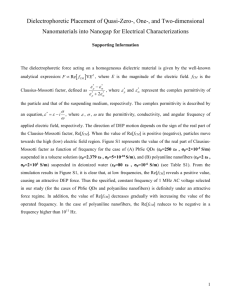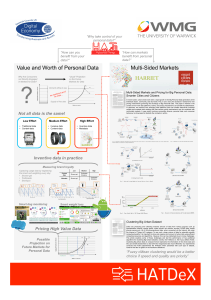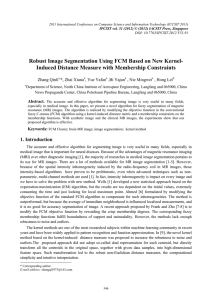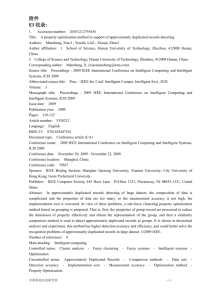Document 13136673
advertisement
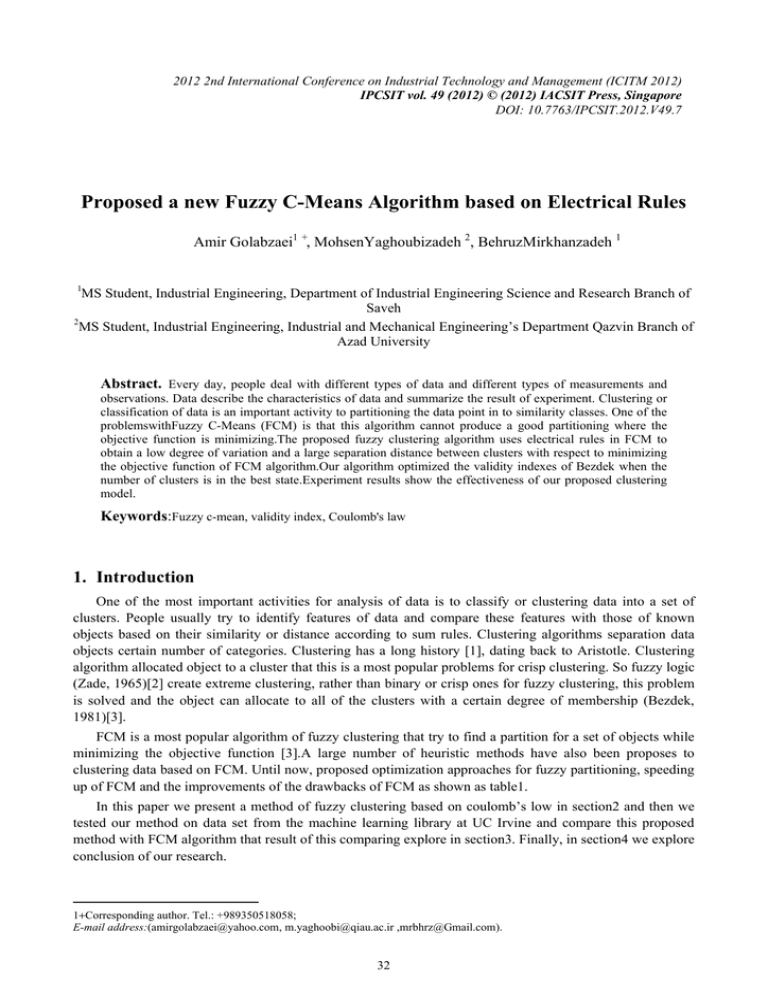
2012 2nd International Conference on Industrial Technology and Management (ICITM 2012)
IPCSIT vol. 49 (2012) © (2012) IACSIT Press, Singapore
DOI: 10.7763/IPCSIT.2012.V49.7
Proposed a new Fuzzy C-Means Algorithm based on Electrical Rules
Amir Golabzaei1 +, MohsenYaghoubizadeh 2, BehruzMirkhanzadeh 1
1
MS Student, Industrial Engineering, Department of Industrial Engineering Science and Research Branch of
Saveh
2
MS Student, Industrial Engineering, Industrial and Mechanical Engineering’s Department Qazvin Branch of
Azad University
Abstract. Every day, people deal with different types of data and different types of measurements and
observations. Data describe the characteristics of data and summarize the result of experiment. Clustering or
classification of data is an important activity to partitioning the data point in to similarity classes. One of the
problemswithFuzzy C-Means (FCM) is that this algorithm cannot produce a good partitioning where the
objective function is minimizing.The proposed fuzzy clustering algorithm uses electrical rules in FCM to
obtain a low degree of variation and a large separation distance between clusters with respect to minimizing
the objective function of FCM algorithm.Our algorithm optimized the validity indexes of Bezdek when the
number of clusters is in the best state.Experiment results show the effectiveness of our proposed clustering
model.
Keywords:Fuzzy c-mean, validity index, Coulomb's law
1. Introduction
One of the most important activities for analysis of data is to classify or clustering data into a set of
clusters. People usually try to identify features of data and compare these features with those of known
objects based on their similarity or distance according to sum rules. Clustering algorithms separation data
objects certain number of categories. Clustering has a long history [1], dating back to Aristotle. Clustering
algorithm allocated object to a cluster that this is a most popular problems for crisp clustering. So fuzzy logic
(Zade, 1965)[2] create extreme clustering, rather than binary or crisp ones for fuzzy clustering, this problem
is solved and the object can allocate to all of the clusters with a certain degree of membership (Bezdek,
1981)[3].
FCM is a most popular algorithm of fuzzy clustering that try to find a partition for a set of objects while
minimizing the objective function [3].A large number of heuristic methods have also been proposes to
clustering data based on FCM. Until now, proposed optimization approaches for fuzzy partitioning, speeding
up of FCM and the improvements of the drawbacks of FCM as shown as table1.
In this paper we present a method of fuzzy clustering based on coulomb’s low in section2 and then we
tested our method on data set from the machine learning library at UC Irvine and compare this proposed
method with FCM algorithm that result of this comparing explore in section3. Finally, in section4 we explore
conclusion of our research.
1+Corresponding author. Tel.: +989350518058;
E-mail address:(amirgolabzaei@yahoo.com, m.yaghoobi@qiau.ac.ir ,mrbhrz@Gmail.com).
32
Table1. Literature review of proposed method for improving FCM
Refrences ID
researchers
[4]
Gath and Geva
[5]
[6]
Kersten
wu and Yang
[7]
Ozdemir and Akarun
[8]
Wu et al
[9]
Cheng and zhang
Approaches
Initialization problem by dynamically adding
cluster centers
Use of fuzzy medians with a city block distance
New possibility algorithm for cost function
Proposed a partition index maximization (PIM)
algorithm
proofing the volumes of each cluster core in
PIM are equal
Entropy based subspace clustering mining
numerical data
Published year
1989
1997
2006
2002
2005
1999
2. A Fuzzy C-Mean Model Based on Coulomb’s Low
The notations used in the paper are introduced follows in table 2.
Table2. Notation of our article
Row
1
2
3
4
5
6
7
8
9
10
2.1.
symbols
1, … ,
uij
U=[uij]c*n
1, … ,
V=[v1,…,vc]
1, … , ∞
Dij=D(xj,mi)
J(p)
Description
Data vector of jth object
Membership coefficient of the jth object in the ith cluster
Fuzzy partition matrix
Cluster number
Cluster center matrix
Fuzzification parameter usually set to 2
Distance between xj and mi
Euclidean distance function
Objective function
Value of data point in data set X
Fuzzy C-Mean Algorithm
FCM is one of the common algorithms of fuzzy clustering methods that proposed withBezdek in
1981[10].
The objective function of FCM method in Eq.1 can be minimizingwith an iterative procedure that leads
to the FCM algorithm. The memberships function and center matrix update equations all obtained through
alternating optimization. The steps of the FCM method are summarizing as follows:
Step1. Select appropriate values for m, c, and a small positive number . initialize the center matrix V
randomly. Set step variable t=0;
Step2. Update the membership matrix U by
1
∑
(2)
Step3. Update the center matrix V by
∑
∑
; for i=1,…,c;
Step4. Repeat steps 2 and 3 until max{||
(3)
−
||≤ε.
Calculate objective function J(p) as follows:
∑ ∑
∑ ∑
2.2.
(4)
Coulomb’s law
33
We used electrical rules that described electrostatic actions between electrical points. Firstly, this rule
proposed withCharls Coulomb[11]. Ration between electrical power and distance lastly discovered with
Henry Cowndish[12]. Point charges that collected generate anelectric filedwith respect to characterize
follows:
1. Represents the electric charge density of the electric field is create.
2. Due to the increased distance between the point charges, the electric field strength decreases.
2.3.
Validity indexes
In generally clustering validity problem can be change to determination of optimum number clusters.
Most studies on cluster validity design for FCM algorithm that reviewed withdubes and jane in 1979[13],
1988. The best known validity indexes were proposed for evaluate cluster validitywithBezdek as follows:
- The partition coefficient:
V
∑
-
The partition entropy:
PE
U
∑
∑
(5)
∑
U log U
(6)
When VPC is the maximum value, the clusters are most compact. and when VPE is the minimum value,
the clusters are the most separation.
Since many heuristic methods are proposed to improve FCM algorithm to obtain maximum compaction
and separation.
3. Proposed algorithm
We present a new fuzzy clustering algorithm based on coulomb’s law. This algorithm seeks to offer the
most compactness of data into clusters and to satisfy the maximum separation between clusters. The
algorithm is usedto calculate the membership degrees of data clustering and updating the membership degree
matrix of a heuristic function based on coulomb’s law.
Proposed algorithm like FCM algorithm followed by minimizing the following function:
Where (n) is data vector of objects, (c) is number of clusters, V is cluster centers matrix and (U) is
membership function matrix that this membership function matrix have to satisfy follows constraints:
I.
µ
0,1 ; 1 i c, 1 k n
(7)
∑ µ
II.
1; 1 k n
(8)
n; 1 i c
(9)
III.
0 ∑
µ
The memberships function and center matrix update equations all obtained through alternating
optimization. The steps of the FCM method are presenting as follows:
Step1. Select appropriate values for m, c, and a small positive number . initialize the center matrix V
randomly. Set step variable t=0;
Step2. Update the membership matrix U by
,
∑
(10)
,
Step3. Update the center matrix V by
34
∑
; for i=1,…,c;
∑
(11)
−
Step4. Repeat steps 2 and 3 until max{||
||≤ε}.
Calculate objective function J(p) as follows:
4. Experimental results
4.1.
Evaluating measures
There are many ways to evaluate how exactly our clustering algorithm performs.We can use many
validity indexes to evaluate and compare performance between our algorithm and FCM algorithm.
Therefore,we use Bezdek’s validity indexes for measuring how exactly of our method.
4.2.
Iris Data set and Wine Data set
In this section, we examine performance of proposed algorithm and compare it with FCM algorithm on
the Iris and Wine database available in the UC Irvine Machine Learning Repository.The Iris database
contains 150 Number of Instances, each instance has 4Number of Attributes: 4 numeric, predictive attributes
and the class and the Wine Database contains 178 number of Wine recognition data kind of wines, each kind
of wine has 13 Number of Attributes. Figure (1) shows the comparison results of our algorithm and FCM
algorithm in Iris data set on (3,4,...,10)number of clusters for VPC value. In number clusters 3,4 our
algorithm shows value of VPC better than FCM algorithm.
cluster
number
3
4
5
6
7
8
9
10
VPC
1
Our
0.8
algorithm
0.783397455
0.785937628
0.6
0.682650808
0.707957301
0.4
0.665761604
0.658932802
0.606769741
0.594392416
0.2
0.592457273
0.552972069
0
0.515994968
0.515126847
3
4
5
6
7
8
9
0.505575483
0.532902197
0.493301794
0.480413626
Fig 1.comparing VPC result between FCM and EFCM on Iris data set
FCM
fcm
efcm
10
Fig 2 shows the comparison results of our algorithm and FCM algorithm in Iris data set on (3,4,...,10)
number of clusters for VPE value.In number clusters 3,4 our algorithm shows value of VPE better than FCM
algorithm.
VPE
cluster
number
FCM
3
4
5
6
7
8
9
10
0.395491604
0.584104143
0.675143102
0.816978436
0.885942127
1.005125227
1.069546107
1.123926595
Our
algorithm
0.391388069
0.558889801
0.685806842
0.799686461
0.913040779
1.003042256
1.067655878
1.133000182
1.5
1
FCM
0.5
EFCM
0
3
4
5
6
7
8
9
Fig 2.comparing VPE result between FCM and EFCM on Iris data set
35
10
Fig 3 shows the comparison results of our algorithm and FCM algorithm in Iris data set on
(3,4,...,10)number of clusters for Objective function value.
cluster
number
3
4
5
6
7
8
9
10
Objective function
8000
Our
FCM
6000
algorithm
6050.571063
6070.610979
4000
4956.572613
4172.882985
3273.280357
3282.031092
2000
2791.493611
2480.821758
0
2421.228631
2044.637526
1803.964363
1809.797136
3
4
5
6
7
8
9 10
1552.704392
2002.155145
1397.982389
1371.472439
Fig 3.comparing VPE result between FCM and EFCM on Iris data set
FCM
EFCM
Fig 4 shows the comparison results of our algorithm and FCM algorithm in Wine data set on (3,4,...,10)
number of clusters for VPC value. In number clusters 3,4 our algorithm shows value of VPC better than
FCM algorithm.
cluster
number
3
4
5
6
7
8
9
10
VPC
0.85
Our
0.8
algorithm
0.790939753
0.799013319
0.75
0.782981911
0.783310761
0.7
0.767545241
0.746762379
0.65
0.74642678
0.747335142
0.6
0.757808986
0.717532853
0.694476051
0.727666625
3 4
5
6 7
8
9 10
0.716355515
0.715829333
0.709314668
0.706538088
Fig 4.comparing VPC result between FCM and EFCM on Wine data set
FCM
FCM
EFCM
Fig 5 shows the comparison results of our algorithm and FCM algorithm in Wine data set on (3,4,...,10)
number of clusters for VPE value.In number clusters 3,4 our algorithm shows value of VPE better than FCM
algorithm.
cluster
number
3
4
5
6
7
8
9
10
VPE
0.8
FCM
Our algorithm
0.380407767
0.370904939
0.6
0.418337915
0.439005255
0.4
0.464952665
0.503812946
0.521833757
0.521349977
0.2
0.505360801
0.597685377
0
0.653683355
0.581739185
0.612783795
0.60985028
3
4
5
6
7
8
9 10
0.632313414
0.638376505
Fig 5.comparing VPE result between FCM and EFCM on Wine data set
FCM
EFCM
5. Conclusion
In generally our algorithm ideas come from similarity between specifications of electrical fields and
clustering algorithms and our proposed algorithm based on heuristic approach. In this paper, we present a
new clustering algorithm based on coulomb’s law that provide 2 validity indexes of Bezdek (VPC, VPE)
compare with FCM algorithm.
We provide separation and compactness of clusters more than FCM method. Experimental results on
document datasets suggest the success of our methodology.
6. References
36
[1] N. Blacel, P.Hansen, N.Mladenovic, fuzzy j-means: a new heuristic for fuzzy clustering, pattern recognition
35(2002)
[2] L.A.Zadeh, fuzzy sets, inf. Control 8(1965) 338-353
[3] J.C.Bezdek, “pattern recognition with fuzzy objective function algorithms”, plenum press, new york, (1981)
[4] Gath I, Geva AB, unsupervised optimal fuzzy clustering. IEEE Trans Pami (1991)
[5] P.R Kersten, L.S. Lee, T.L. Ainsworth, Unsupervised classification of polarimetric synthetic aperture radar images
using fuzzy clustering and EM clustering, IEEE Trans. Geosci. Remote sensing 43(3) (2005)
[6] Wu J, Yang Z. A fuzzy subspace clustering for high dimensional categorical data. (2006)
[7] D.O¨zdemir, L.Akarun, A fuzzy algorithm for color quantization of images, PatternRecognition35 (2002)1785–
1791.
[8] K.L. Wu, J. Yu, M.S. Yang, A novel fuzzy clustering algorithm based on a fuzzy scatter matrix with optimality
tests, Pattern Recognition Lett.26(2005) 639–652.
[9] Cheng, C, FU, A, and Zhang, Y. Entropy-based subspace clustering for mining numerical data.ACM SIGKDD.
New York (1999).
[10] Zimmermann, H.J, Hans-Jürgen, Fuzzy set theory and its applications, 2nd, Revised Edition, 1991.
[11] Roberts, Elliott, Electromagnetics History theory and applications. ISBN 978-0-7803-5384-8.
[12] James Clerk Maxwell,ed. The electrical researches ofthe honorable Cavendish, Cambridge University Press.
[13] Dubes, R.C, jain, A.k , algorithm for clustering data , Englewood cliffs,prentiee Hall,1988.
37

